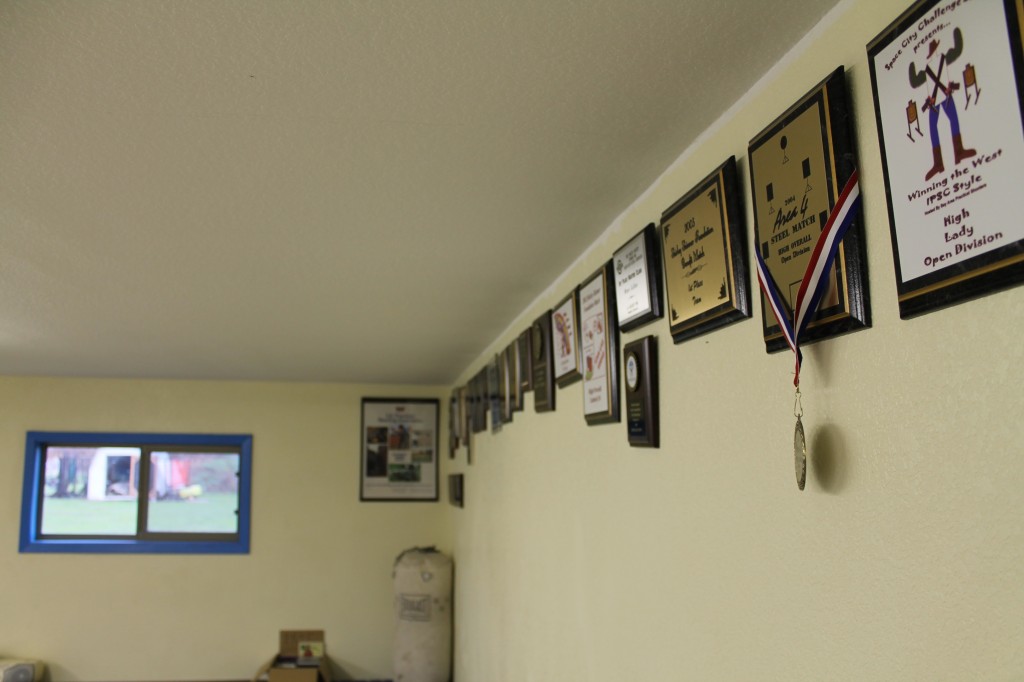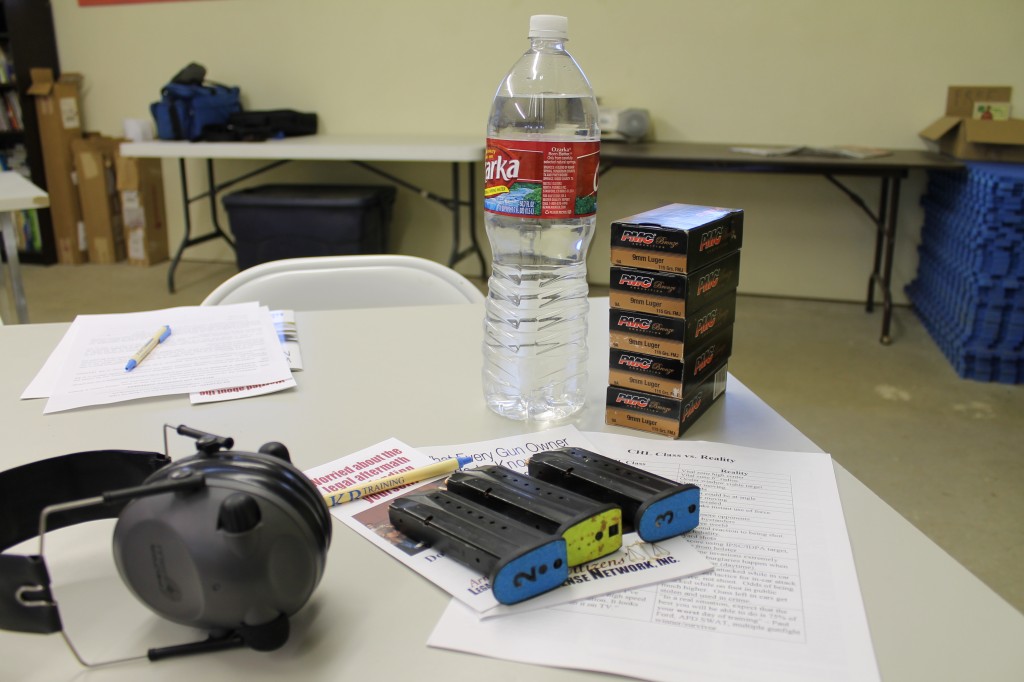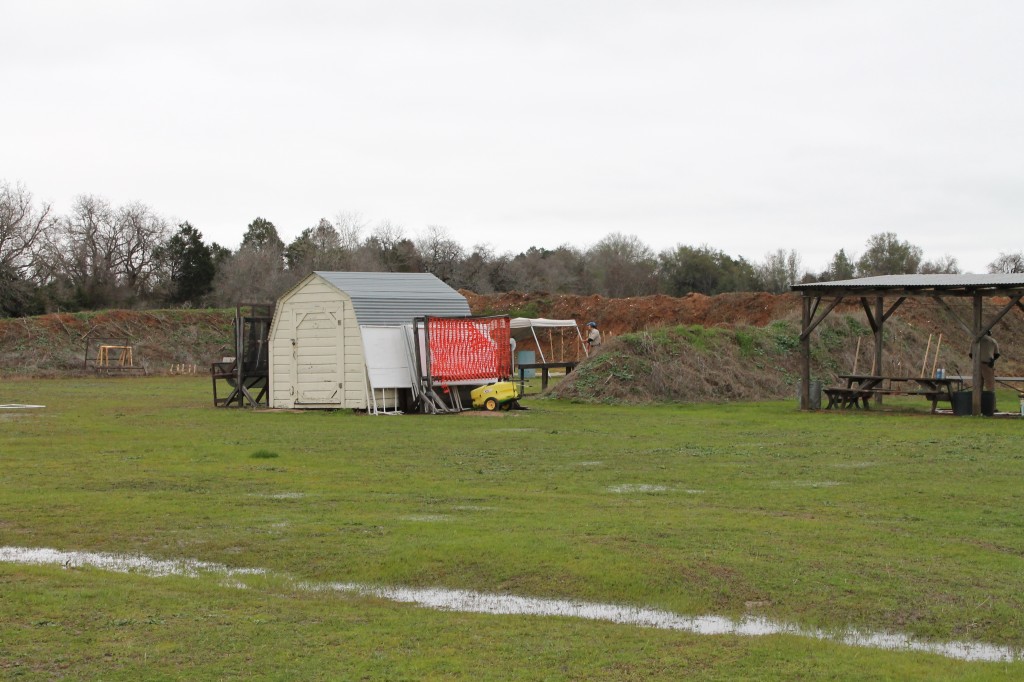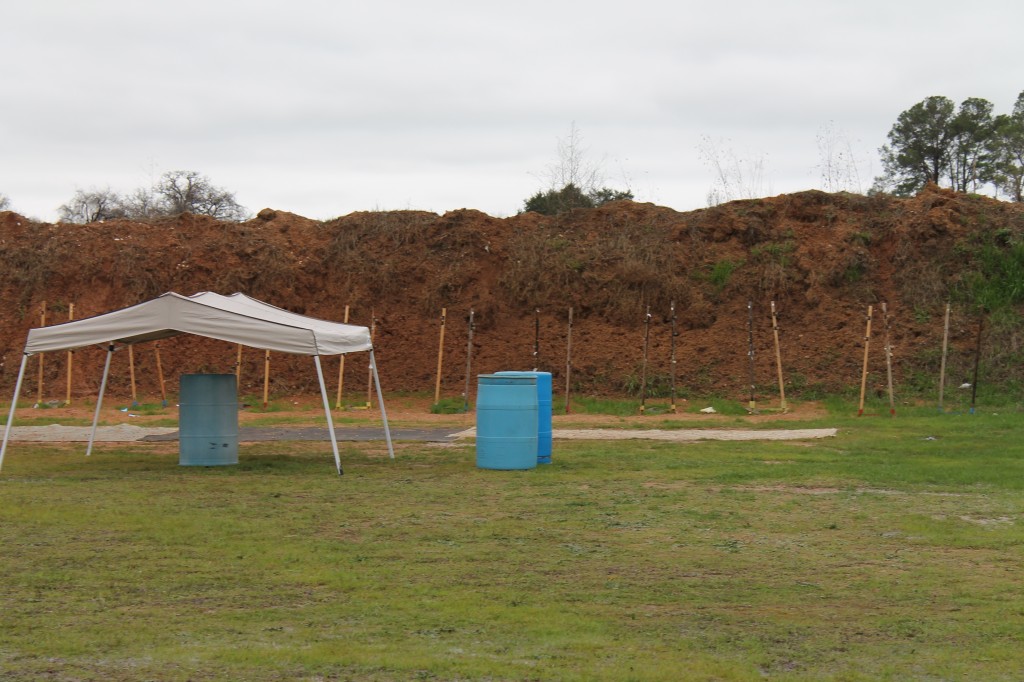There’s something to be said for a group of instructors that embrace a rainy day. It figures that the one day that it rains in Austin is the day that I was headed out to KR Training for Defensive Pistol Skills. There’s also something to be said for instructors pointing out repeatedly that it might not be 70 and sunny the day you have to defend yourself. Better to practice for the worst and hope for the best. Rain or shine, I spent a solid five hours with the group at KR and came away completely impressed with their program . . .
KR Background
Karl Rehn started KR Training back in 1991 before the CHL process even existed in Texas. From the beginning, they have focused on bringing high quality firearms training to Austin and the surrounding area. In fact, Karl and two of his fellow instructors were in the first CHL instructor class held by the Texas Department of Public Safety. That experience shows in the classroom and on the range.

The facility is a no frills affair located out towards Giddings, TX. There is a bathroom, a well-lit classroom, a big whiteboard, and a ton of trophies on the wall.
The range is similarly utilitarian. You will not find $2500 steel pop targets out there. As a student, I like that a lot. I don’t really care for flash. Luckily for me, the KR program is all substance. They have a plethora of classes running year round (rain or shine) from absolute novice to highly trained competitor.
Defensive Pistol Class
The focus of this class is not to turn students into the next Chris Costa. This class is the foundation for many more advanced classes to be added at a later date. We spent the morning focusing on holster and gun selection, smooth/controlled draws from concealment, and effective shooting techniques. The entire process was engaging and fun while still maintaining a high level of professionalism.
I started my day by proving that I was competent to handle a firearm under the watchful gaze of two instructors. They had me line up five yards from two plastic dummies. My instructions were to shoot both dummies starting from a low ready position. Easy enough right? Tap-Tap. Tap-Tap. That’s when instructor John Daub nodded, made me show clear, and then let me know that the dummies have a steel plate inside. When you score a hit, they go down. Mine didn’t.
“Am I dead?” I asked. “Maybe. They are probably still in the fight,” John replied. This proved to be one of many reminders that I would get about shot placement during the day.
After getting knocked down a peg, we started the classroom portion talking about the psychology of shooting another human. Specifically, Karl focused on a case study from a shootout a few years ago between an 18 year old man and several well-armed police officers. The shoot lasted for approximately 3.5 minutes and the BG took multiple hits and kept reloading his single 1911 magazine and returning fire.
I believe the final wound total at the time of his death was 17 separate hits including one to the foot, hip, and several to the chest. One of the officers involved in the shooting was hit almost immediately in the left forearm and stated that he was not able to return fire and was out of the fight. Karl used this as an opportunity to show that mindset is everything when it comes to DGUs. Keep your head about you, and stay in the fight.
After that rather sobering talk, we reviewed basic gun safety rules and talked about holster and gun selection. Karl and crew are big proponents of finding the gun that you are most comfortable shooting and working on a concealment strategy from there. They are of the opinion that too often, people choose pocket rockets for concealment only to sacrifice their shooting comfort which negatively impacts their desire to train often enough with their EDC gun.
On the topic of holsters, KR encourages students to utilize an IWB holster at the 3-4 o’clock position. Specifically, the Comp-Tac and Blade Tech. I wore one of the CTAC holsters that made a full sized M&P 9 absolutely disappear. I actually got to model in front of the entire class (probably because of my youthful exuberance and good looks). Even with a somewhat tight long sleeve shirt, you’d never know that I was carrying. Add that to the must-buy list.
After the administrative work was done, we cleared the tables and spent the next hour in the classroom working on proper grip and the four-step draw KR teaches. I’d like to take a moment right now to confess that I thought I had a pretty good grip on things, literally speaking. I knew that I was going to learn a ton about drawing and shooting quickly, but I had no idea how jacked my grip was. It turns out that my support hand really wasn’t doing anything but sitting there and looking pretty.
Karl’s instructors taught me to rotate my support hand about 45 degrees to take advantage of an entire group of unused muscles in my forearm. Doing this creates a very effective lever to control muzzle flip. This little change made a HUGE difference in my control during the shooting phase of class. I cannot stress enough just how much of an “ah ha!” moment this was for me. You can see a better explanation of this grip here. Next on the agenda was the draw. We broke it down to four components and worked on each one until the entire class was smooth-drawing like Eastwood.
Our last “dry” exercise was on trigger management. Luckily, the loaner M&P had one of those sweet Apex Tactical trigger kits installed and it was very easy to find the reset point after each squeeze. I did not keep an exact count, but it’s safe to say that before we even fired a live round, we did at least 200 draws from the holster and 75-100 dry fires.
Live Fire
I want to get this out of the way before I get much further. Karl and his group are pros at this. I thoroughly enjoyed my class and it was by far the most productive five hours I’ve spent at the range in a long time. And while dry fire was good, the KR Team really shines out on the range. When the lead starts flying, these guys really go to work.
Right from the start, they split our class of thirteen into two groups. One would shoot and do drills while the other reloaded, hydrated, and watched. This has the most excellent benefit of putting four instructors on six to seven students. It seemed as soon as I made a mistake, there was somebody in my ear to coach me back on the right track. More importantly, they kept a watchful eye on range discipline. Luckily we only had one instance where a student started to scan and brought their gun along for the ride. One of the instructors was on him instantly before he had a chance to muzzle the entire class.
The live fire portion was built on top of the work we’d done in the classroom prior to taking the show outdoors. We worked on full presentation from the holster, shoot/don’t shoot drills, scanning after firing, and making a decision on whether to engage another target or holster. The focus the entire time was on critical thinking skills with just a touch of stress mixed in. I measured my heart rate at some point during class and was running above 100 BPM. Mildly stressful indeed.
We finished the class by shooting Karl’s Three Seconds or Less drill. Your loyal scribe managed to shoot a 95. Not bad considering I was running a rented gun and holster. That, and the fact that I knew jack about effective pistol shooting when I started the class. I wish we’d started the class with this test to get a true barometer on our improvement. I would have even settled for another crack at those plastic dummies that mocked me earlier.
Conclusion
This was, flat out, the most productive range session I’ve ever had. In the time I made it public that I was attending a KR class, I had two friends contact me to let me know that they had taken no less than six classes from KR. People don’t make that drive and spend that kind of coin unless they are getting something out of the experience. I would gladly invest more time and money with the guys and gals at KR.
I saw a marked improvement in my skills in the span of five hours. Most important was that I came away feeling much more confident about carrying daily. As a fun bonus, you can read what John Daub had to say about the day on his personal website. I can only tell you so much from a student perspective, but getting the instructor’s view is excellent as well.

KR Training: Defensive Pistol Skills 1
Prerequisites: Texas CHL or instructor approval required. Basic Pistol 2 or Beyond the Basics or equivalent training, and/or a score of 90% of better on the Texas CHL shooting test strongly recommended.
Round Count: Minimum of 200 rounds of ammunition. I used about 150, but students are encouraged to bring extra and get liberal with their firing. Only brass or nickel case allowed. NO steel case ammo.
Required Equipment: A centerfire handgun, belt holster, a minimum of 2 spare magazines or speedloaders, magazine/speedloader carriers, eye and ear protection, and a baseball cap.
Time: 3 hours (advertised) but could stretch to 5 depending on the weather.
Cost: $80
Ratings (Out of 5 Stars):
Technical Instruction: * * * * *
These guys were all top notch. They seemed to know what the other was thinking and worked very effectively as a team.
Safety: * * * * *
We used dummy guns for all of our grip and stance work. They were religious about chamber checks before all dry fire practice. To top it off, they kept a guy from muzzling the entire class.
Facility: * * * *
If you like flashy things, KR’s A Zone Range might not be your cup of tea. However, if you like a well thought out, effective space to better your skills, you will like it just fine.
Overall: * * * * *
I learned to draw from a holster and put a meaningful three rounds on target at three yards in under three seconds. I couldn’t have done that with an entire day at the range by myself. Do yourself the favor and go visit the guys and gals at KR. You will not be disappointed.








Tyler, it was a pleasure to have you out. You were a good student and it showed in your progress in the class. I bet you’ll have no problems with the pre-class “pop quiz” now. Come back for Defensive Pistol Skills 2 and you’ll get to try again. 🙂
Thank you for the kind words.
– John “Hsoi” Daub
$80 for 3-5 hours of quality instruction is quite a bargain. Sounds like they definitely covered all the basics: 4-count draw stroke, thumbs-forward grip, trigger control. That’ll be a good foundation to build on. If they’re starting out that strong, it’s very likely the other classes are worthwhile too.
I did chuckle at the recommendation of Comp-Tac and Blade Tech holsters. Even without any other background, that little bit of information tells me that these guys probably have a significant amount of experience. People who deal with handguns for any length of time tend to come to similar conclusions. Just about every serious shooter I know has settled on those two brands.
Tyler, do you know what their reasoning behind no steel case ammo is?
They’re not reloadable.
Lots of brass is generated, of course, and the brass is picked up with our little “brass zamboni”. The brass is eventually shipped off and reloaded. The reloaded ammo then gets used in classes like Basic Pistol 1, where we provide a buffet of guns (and ammo for them) which permits new shooters to sample a variety of guns to help them gain a better idea of what works for them and thus what to buy. All this recycling helps keep costs down.
No one has the time to sort through that volume of casings to sort out what’s reloadable and what’s not. Thus the “brass-only” policy.
I remember getting a similar “eureka” moment about my grip. I was shooting terribly and one of the recon Marines came over and gave me one piece of advice about keeping my strong hand’s palm flat on the grip and my score jumped from 300 to 350.
I have taken 5 or more classes with the guys at KR and everyone was worth the time and money. Like Tyler said it is the most productive time I have spent at the range and would highly recommend them to anyone looking for basic to advanced training.
This post by John Daub (http://blog.hsoi.com/2010/11/06/its-not-a-miss-its-an-unacceptable-hit/) which was linked off his post about the class is one of the best I’ve read in a long time, and GREAT food for thought.
Thank you for the kind words.
I have taken three classes w/ Karl over the years, they are great. Best money I have ever spent, and Riboflavin is adorable.
Thanks for the review. I have been considering KR for a CHL class and this one and it was good to read your AAR.
This was helpful. Thanks for authoring this informative piece.
Comments are closed.